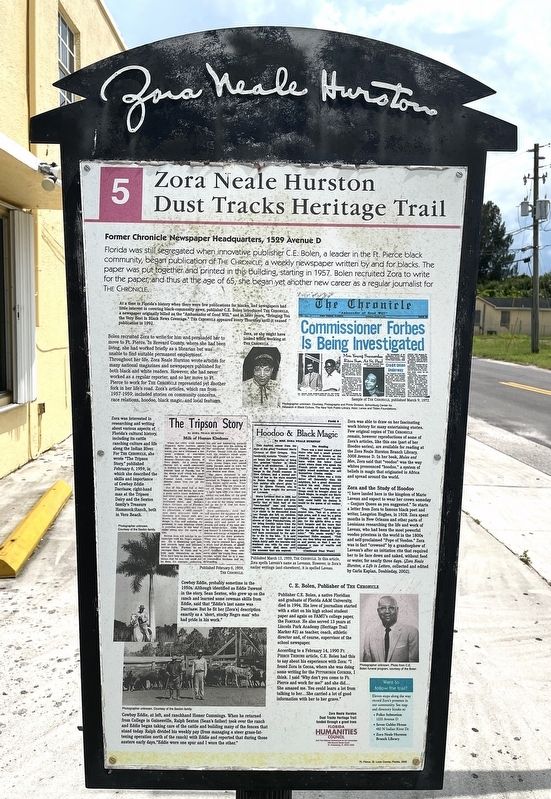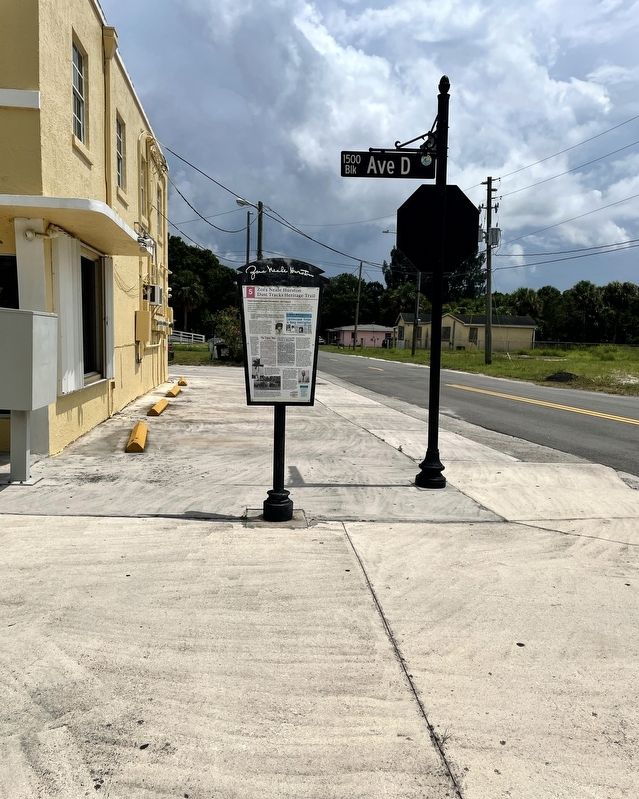Fort Pierce in St. Lucie County, Florida — The American South (South Atlantic)
Former Chronicle Newspaper Headquarters
— Zora Neale Hurston Dust Tracks Heritage Trail —
Former Chronicle Newspaper Headquarters, 1529 Avenue D
Florida was still segregated when innovative publisher C.E. Bolen, a leader in the Ft. Pierce black community, began publication of The Chronicle a weekly newspaper written by and for blacks. The paper was put together and printed in this building, starting in 1957. Bolen recruited Zora to write for the paper, and thus at the age of 65, she began yet another new career as a regular journalist for The Chronicle
At a time in Florida's history when there were few publications for blacks, and newspapers had little interest in covering black community news, publisher C.E. Bolen introduced The Chronicle a newspaper originally billed as the “Ambassador of Good Will,” and in later years, “Bringing You the Very Best in Black news coverage.” The Chronicle appeared every Thursday until it ceased publication in 1992.
Bolen recruited Zora to write for him and persuaded her to move to Ft. Pierce. In Brevard County, where she had been living, she had worked briefly as a librarian but was unable to find suitable permanent employment. Throughout her life, Zora Neale Hurston wrote articles for many national magazines and newspapers published for both black and white readers. However, she had never worked as a regular reporter, and so her move to Ft. Pierce to work for The Chronicle represented yet another fork in her life's road. Zora's articles, which ran from 1957-1959, included stories on community concerns, race relations, hoodoo, black magic, and local features.
Zora was able to draw on her fascinating work history for many entertaining stories. Few original copies of The Chronicle remain, however reproductions of some of Zora's articles, like this one (part of her Hoodoo series), are available for reading at the Zora Neale Hurston Branch Library, 3008 Avenue D. In her book, Mules and Men, Zora said that "voodoo" was the way whites pronounced "hoodoo," a system of beliefs in magic that originated in Africa and spread around the world.
Zora and the Study of Hoodoo
"I have landed here in the kingdom of Marie Lavean and expect to wear her crown someday - Conjure Queen as you suggested." So starts a letter from Zora to famous black poet and writer, Langston Hughes, in 1928. Zora spent months in New Orleans and other parts of Louisiana researching the life and work of Laveau, who had been the most powerful voodoo priestess in the world in the 1800s and self-proclaimed "Pope of Voodoo." Zora was in fact "crowned" by a grandnephew of Lavean's after an initiation rite that required her to lie face down and naked, without food or water, for nearly three days. (Zora Neale Hurston, a Life in Letters, collected and edited by Carla Kaplan, Doubleday, 2002).
C.E. Bolen, Publisher of The Chronical
Publisher C.E. Bolen, a native Floridian and graduate of Florida A&M University, died in 1994. His love of journalism started with a stint on his high school student paper and again on FAMU's college paper, the FAMCEAN. He also served 13 years at Lincoln Park Academy (Heritage Trail Marker #2) as teacher, coach, athletic director and, of course, supervisor of the school newspaper.
According to a February 14, 1990 Ft. Pierce Tribune article, C.E. Bolen had this to say about his experience with Zora: "I found Zora in Cocoa, where she was doing some writing for the Pittsburgh Courier, I think. I said ‘Why don't you come to Ft. Pierce and work for me?' and she did… She amazed me. You could learn a lot from talking to her...She carried a lot of good information with her to her grave.”
(Captions)
Zora, as she might have looked while working at The Chronicle.
Photographer unknown. Courtesy, Photographs and Prints Division, Schamburg Center for Research in Black Culture, The New York Public Library, Astor, Lenox and Tilden Foundations.
Zora was interested in researching and writing about various aspects of Florida's cultural history, including its cattle ranching culture and life along the Indian River For The Chronicle, she wrote "The Tripson Story," published February 6, 1959, in which she described the skills and importance of Cowboy Eddie Darrisaw, right hand man at the Tripson Dairy and the Sexton family's Treasure Hammock, Ranch, both in Vero Beach.
Published February 6, 1959, The Chronicle.
Cowboy Eddie, probably sometime in the 1950s. Although identified as Eddie Dawson in the story, Sean Sexton, who grew up on the ranch and learned some cowman skills from Eddie, said that "Eddie's last name was Darrisaw. But he fit her (Zora's) description exactly as a 'short, stocky Negro man' who had pride in his work.”
Photographer unknown. Courtesy of the Sexton family.
Cowboy Eddie, at left, and ranchhand Homer Cummings. When he returned from College in Gainesville, Ralph Sexton (Sean's father) took over the ranch and Eddie began taking care of the cattle and building many of the fences that stand today. Ralph divided his weekly pay (from managing a steer grass-fattening operation north of the ranch) with Eddie and reported that during those austere early days,"Eddie wore one spur and I wore the other."
Photographer unknown. Courtesy of the Sexton family.
Erected by Florida Humanities Council, St. Lucie County and the City of Fort Pierce. (Marker Number 5.)
Topics. This historical marker is listed in these topic lists: African Americans • Civil Rights • Communications • Women. A significant historical year for this entry is 1957.
Location. 27° 27.167′ N, 80° 20.431′ W. Marker is in Fort Pierce, Florida, in St. Lucie County. Marker is at the intersection of Avenue D and North 16th Street, on the left when traveling east on Avenue D. Touch for map. Marker is at or near this postal address: 1529 Avenue D, Fort Pierce FL 34950, United States of America. Touch for directions.
Other nearby markers. At least 8 other markers are within walking distance of this marker. Highwaymen Obelisk (about 400 feet away, measured in a direct line); Julius Caesar Scott (approx. 0.2 miles away); Means Court School (approx. ¼ mile away); Lincoln Park Academy (approx. ¼ mile away); a different marker also named Lincoln Park Academy (approx. 0.4 miles away); a different marker also named Lincoln Park Academy (approx. 0.4 miles away); Zora Neale Hurston House (approx. 0.6 miles away); Sarah’s Memorial Chapel, Formerly Percy S. Peek Funeral Chapel, 728 Avenue D (approx. 0.6 miles away). Touch for a list and map of all markers in Fort Pierce.
Also see . . . Zora Neale Hurston Dust Tracks Heritage Trail. (Submitted on July 19, 2022, by Brandon D Cross of Flagler Beach, Florida.)
Credits. This page was last revised on July 20, 2022. It was originally submitted on July 19, 2022, by Brandon D Cross of Flagler Beach, Florida. This page has been viewed 145 times since then and 20 times this year. Photos: 1, 2. submitted on July 19, 2022, by Brandon D Cross of Flagler Beach, Florida. • Bernard Fisher was the editor who published this page.

